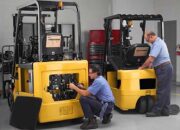Safety regulations when operating container forklifts in ports Operating a container forklift in a port requires strict adherence to safety regulations to ensure the safety of yourself and those around you. Here are some important regulations when operating a container forklift in a port:
- Training requirement: Before operating a container forklift, you must complete a training course and receive the appropriate certification. Make sure you have the knowledge and skills necessary to operate the container forklift safely and efficiently.
- Use of personal protective equipment: Equip yourself with proper personal protective equipment, including a helmet, safety shoes, reflective vest, and gloves. Ensure that these protective gears are always worn when operating the container forklift.
- Pre-use inspection: Before each shift, inspect the container forklift to ensure that all systems are functioning properly. This includes checking the braking system, steering system, lighting, and warning horn.
- Adherence to traffic rules: When operating a container forklift in the port, follow all traffic rules and port signage. Maintain a safe distance from other vehicles and reduce speed when moving.
- Determine and reduce load weight: Understand the size and weight of the container to be lifted. Ensure that the container forklift is capable of safely lifting and transporting the container. Avoid exceeding the permissible load capacity of the container forklift.
- Monitor the environment: Pay close attention to the surrounding environment while operating the container forklift. Avoid obstacles, unsafe road conditions, and areas with pedestrian traffic.
- Follow instructions and signals: Always listen to and follow the instructions of the port and operating personnel. Additionally, use the container forklift’s signals and warning indicators to communicate your actions to those around you.
- Use proper lifting techniques: When lifting containers, adhere to proper lifting techniques to avoid container tipping or damaging the cargo inside. Use precise lifting points on the container and ensure that it is securely fastened on the lifting carriage.
- Perform brake checks: Prior to moving, perform brake checks to ensure that they are functioning correctly. This is crucial for the ability to stop the forklift quickly and safely when necessary.
- Limit speed: Maintain a safe speed and adjust the speed of the container forklift according to environmental conditions and work situations. Limit speed when encountering obstacles, corners, or areas with the presence of others.
- Do not exceed the capacity of the forklift: Understand and comply with the load capacity and operating capabilities of the container forklift. Do not exceed the limits of the forklift to avoid damaging the equipment or posing a risk to yourself and others.
- Report incidents: In case of any incidents or issues related to the container forklift, report them immediately to management or the technical department for inspection and repair. Do not use the container forklift in an unsafe condition.
Perform regular maintenance: Ensure that the container forklift undergoes regular maintenance as prescribed by the manufacturer. Inspect and maintain the systems and components of the container forklift to ensure their stable and safe operation.







